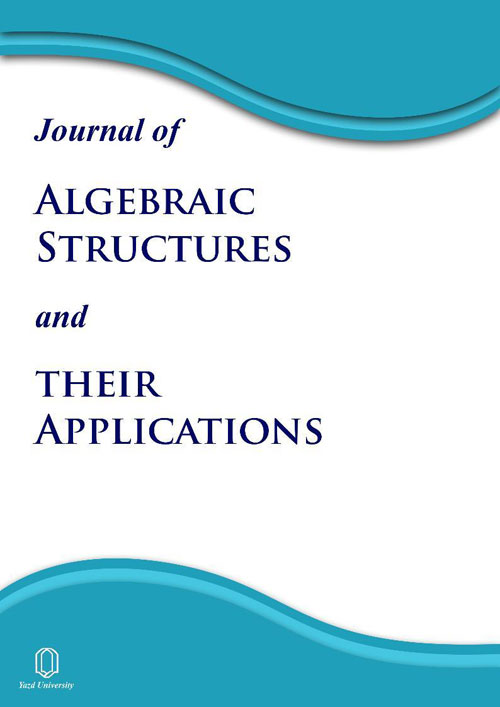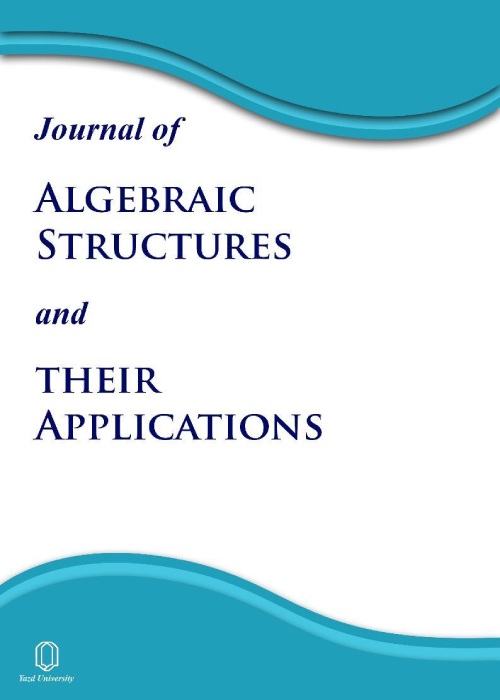فهرست مطالب

Journal of Algebraic Structures and Their Applications
Volume:2 Issue: 1, Winter - Spring 2015
- تاریخ انتشار: 1394/11/18
- تعداد عناوین: 6
-
-
Pages 1-9Let R be a commutative ring and M be an R-module with T(M) as subset, the set of torsion elements. The total graph of the module denoted by T(Γ(M)), is the (undirected) graph with all elements of M as vertices, and for distinct elements n,m∈M, the vertices n and m are adjacent if and only if n∈T(M). In this paper we study the domination number of T(Γ(M)) and investigate the necessary conditions for being Zn as module over Zm and we find the domination number of T(Γ(Zn)).Keywords: total graph, domination number, module
-
Pages 11-22In this paper, we introduce the notions of product vague graph, balanced product vague graph, irregularity and total irregularity of any irregular vague graphs and some results are presented. Also, density and balanced irregular vague graphs are discussed and some of their properties are established. Finally we give an application of vague digraphs.Keywords: Vague graph, density, balanced irregular vague graph, product vague graph
-
Pages 23-34A multicone graph is defined to be join of a clique and a regular graph. A graph G is cospectral with graph H if their adjacency matrices have the same eigenvalues. A graph G is said to be determined by its spectrum or DS for short, if for any graph H with Spec(G)=Spec(H), we conclude that G is isomorphic to H . In this paper, we present new classes of multicone graphs that are DS with respect to their spectrums. Also, we show that complement of these graphs are DS with respect to their adjacency spectrums. In addition, we show that graphs cospectral with these graphs are perfect. Finally, we find automorphism group of these graphs and one conjecture for further researches is proposed.Keywords: Adjacency spectrum, Laplacian spectrum, Multicone graph, DS graph, Automorphism group
-
Pages 35-47In this paper we introduce the notions of uniformly quasi-primary ideals and uniformly classical quasi-primary submodules that generalize the concepts of uniformly primary ideals and uniformly classical primary submodules; respectively. Several characterizations of classical quasi-primary and uniformly classical quasi-primary submodules are given.
Then we investigate for a ring R, when any finite intersection of (uniformly) primary submodules of any R-module is a (uniformly) classical quasi-primary submodule. Furthermore, the behavior of classical quasi-primary and uniformly classical quasi-primary submodules under localizations are studied. Also, we investigate the existence of (minimal) primary submodules containing classical quasi-primary submodules.Keywords: Classical quasi-primary, Uniformly classical quasi-primary -
Pages 49-58The aim of this paper is to initiate and investigate new soft sets over semihypergroups, named special soft sets and transitive soft sets and denoted by SH and TH, respectively. It is shown that TH=SH if and only if β=β∗.
We also introduce the derived semihypergroup from a special soft set and study some properties of this class of semihypergroups.Keywords: soft sets, transitive soft sets, (semi)hypergroup, strongly regular relation -
Pages 59-71In \cite{GL}, B. Gerla and I. Leu\c{s}tean introduced the notion of similarity on MV-algebra. A similarity MV-algebra is an MV-algebra endowed with a binary operation S that verifies certain additional properties. Also, Chirte\c{s} in \cite{C}, study the notion of similarity on \L ukasiewicz-Moisil algebras. In particular, strong similarity \L ukasiewicz-Moisil algebras were defined. In this paper we define and study the variety of similarity symmetric Heyting algebras (or similarity DH-algebras), i.e. symmetric Heyting algebras endowed with an operation of similarity S. These algebras are a generalization of strong similarity \L ukasiewicz-Moisil algebras. In addition, we introduce a propositional calculus and prove this calculus has similarity DH-algebras as algebraic counterpart.Keywords: symmetric Heyting algebras, similarity, S--filter


